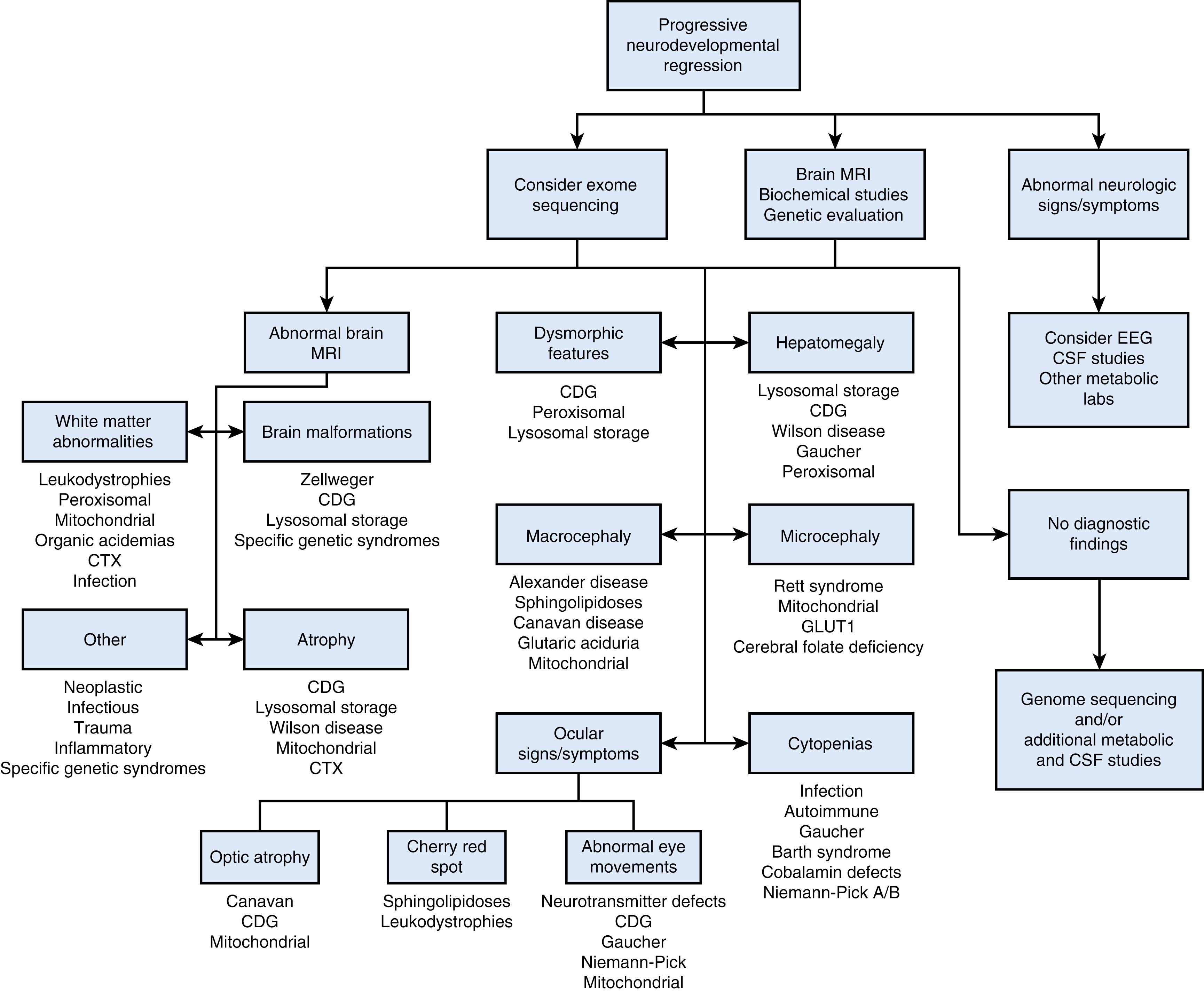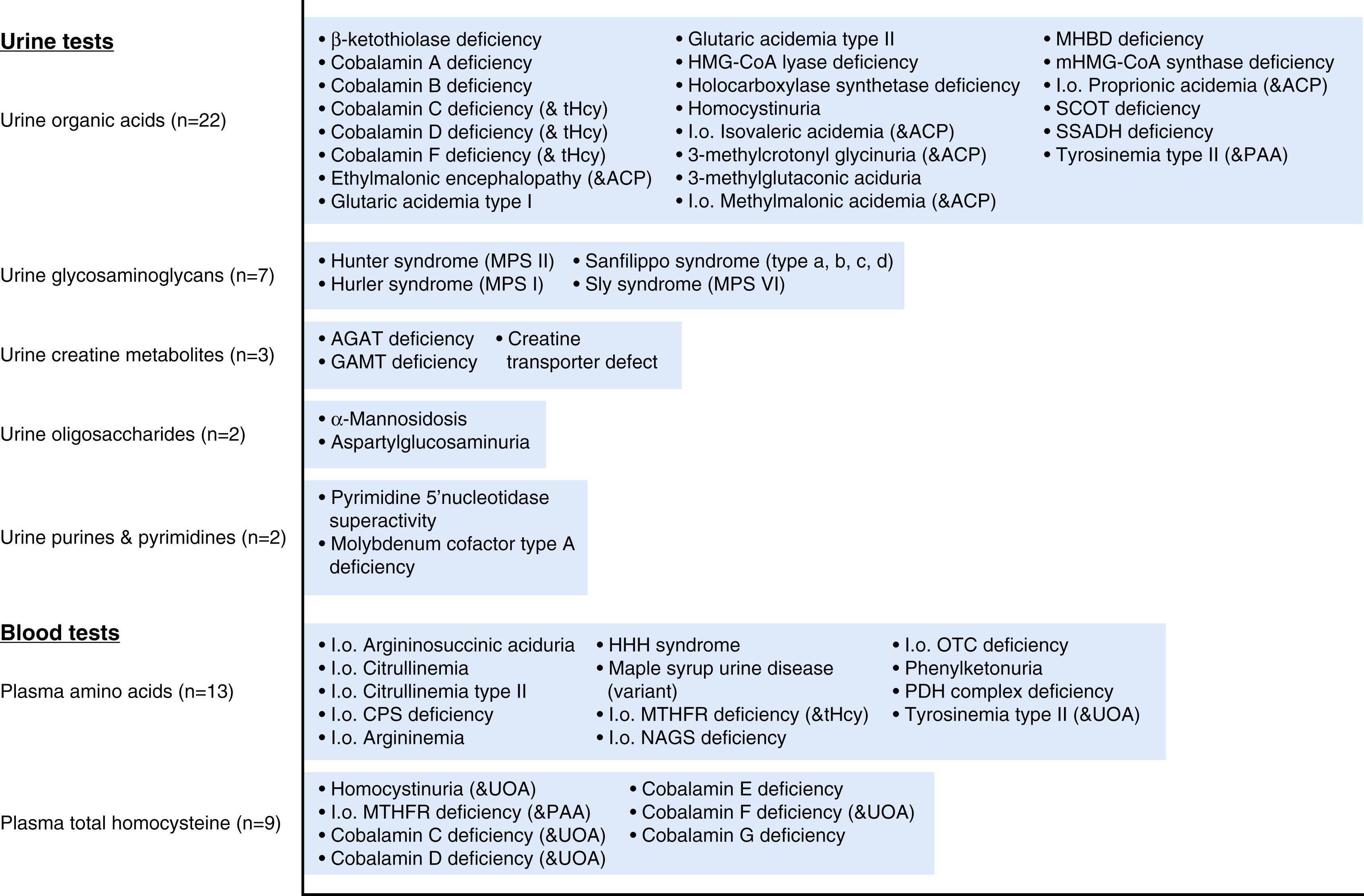Physical Address
304 North Cardinal St.
Dorchester Center, MA 02124
The etiology of intellectual developmental disabilities includes a wide spectrum of disorders that may present at different periods of development (infantile, juvenile, adult) and with different trajectories ( Fig. 28.1 ). Some are static encephalopathies (cerebral palsy, hypoxic-ischemic encephalopathy), while others are progressive, resulting in intellectual, neurologic, and/or developmental regression ( Table 28.1 ).
Any child who fulfills all the following three criteria:
Excluding: static intellectual loss, e.g., after encephalitis, head injury, or near drowning
|
Dominant etiologic categories include:
Storage diseases including leukoencephalopathies
Inborn errors of metabolism including mitochondrial disorders
Genetic and idiopathic epilepsy encephalopathies
Cerebrovascular diseases
Trauma
Progressive neurocognitive regression is an uncommon but important presentation to recognize, diagnose, and potentially treat. The cardinal feature is usually first stagnation and then loss of developmental milestones in young children or loss of abilities, especially cognitive, in older children. The deficits can be slow or rapidly progressive and may or may not be accompanied by other neurologic signs and symptoms. Early recognition and treatment, when possible, may prevent permanent neurologic deficits. Distinguishing delayed development from arrested development or loss of skills can be challenging, especially on first presentation when there are insufficient data to predict the overall trajectory. The recognition of subtle features depends on both parental reporting and careful developmental screening by primary care providers. Overt symptomatology or rapid decline is unlikely to go unnoticed and requires urgent evaluation in all cases. The differential diagnosis of neurodegenerative conditions is broad and includes genetic, neurologic, infectious, immunologic, endocrine, traumatic, and idiopathic conditions. Initial referral to multiple specialists may be needed.
Distinguishing delayed development from arrested development can be challenging, especially on first presentation when there are insufficient data to predict the overall trajectory. Normal development can include brief, transient plateaus or minor losses of skills that occur prior to a significant leap forward in overall development or during concurrent illness. In such cases careful observation and close follow-up will be reassuring. There are certain key elements to consider when taking a history or examining a patient that may trigger deeper exploration for the possibility of regression or intellectual disability (ID) ( Tables 28.2 and 28.3 ). Careful neurocognitive assessment is essential when there are subtle or ill-defined but concerning losses of skills or arrest of development. Referral for neuropsychologic evaluation is essential to correctly establish the specific areas of weakness or change and establish a baseline for the developmental diagnosis.
General
Developmental History
Family Health History
|
Head Circumference
Dysmorphic Features
Ophthalmology
Neurology
Skin
Visceromegaly
Other
|
Developmental regression should be considered as a separate diagnostic entity, unique from global developmental delay (GDD) or ID (see Chapter 27 ) even though there are overlapping conditions. Identifying true regression, rather than failure of development, may be challenging and require close follow-up over a period of time. Once regression is identified, evaluation is warranted.
If the arrest in development is more abrupt, global, or associated with other neurologic signs and symptoms, urgent evaluation is indicated. This may include referral to neurology and/or medical genetics, both basic labs (comprehensive metabolic panel, thyroid studies, blood counts) and specific laboratory studies based on accompanying symptoms, brain MRI, and EEG ( Table 28.4 and Figs. 28.2 and 28.3 ). A specific subset of metabolic disorders can present with regression and various treatment options are available; it is thus important to recognize and diagnose these potentially treatable disorders ( Tables 28.5 and 28.6 ). An exception to this rule is the loss of social and communication skills that precedes a diagnosis of autism in ∼30% of cases. Neuropsychologic evaluation is required to determine whether the regression is part of the autistic spectrum (see Chapter 32 ).
Blood
Cerebrospinal Fluid
Urine
BRAIN MRI with consideration for targeted spectroscopy
|
∗ This evaluation is often coincident with the evaluation for intellectual disability (see Chapter 27 ).


| Age at Onset (yr) | Conditions | Comments |
|---|---|---|
| <2, with hepatomegaly | Fructose intolerance | Vomiting, hypoglycemia, poor feeding, failure to thrive (when given fructose) |
| (see Chapter 17 ) | ||
| Galactosemia | Lethargy, hypotonia, icterus, cataract, hypoglycemia (when given lactose) | |
| Glycogenosis (glycogen storage disease) types I–IV | Hypoglycemia, cardiomegaly (type II) | |
| Mucopolysaccharidosis types I and II | Coarse facies, stiff joints | |
| Niemann-Pick disease, infantile type | Gray matter disease, failure to thrive | |
| Tay-Sachs disease | Seizures, cherry-red macula, edema, coarse facies | |
| Zellweger (cerebrohepatorenal) syndrome | Hypotonia, high forehead, flat facies | |
| Gaucher disease type II | Extensor posturing, irritability | |
| Carbohydrate-deficient glycoprotein syndromes | Dysmyelination, cerebellar hypoplasia | |
| < 2, without hepatomegaly | Krabbe disease | Irritability, extensor posturing, optic atrophy, and blindness |
| Rett syndrome | Females with deceleration of head growth, loss of hand skills, hand wringing, impaired language skills, gait apraxia | |
| Maple syrup urine disease | Poor feeding, tremors, myoclonus, opisthotonos | |
| Phenylketonuria | Light pigmentation, eczema, seizures | |
| Menkes kinky hair disease | Hypertonia, irritability, seizures, abnormal hair | |
| Subacute necrotizing encephalopathy of Leigh | White matter disease | |
| Cerebro-oculofacioskeletal syndrome (of Pena and Shokeir) | Reduced white matter, failure to thrive | |
| Canavan disease | White matter disease | |
| Pelizaeus-Merzbacher disease | White matter disease | |
| 2–5 | Niemann-Pick disease types III and IV | Hepatosplenomegaly, gait difficulty |
| Wilson disease | Liver disease, Kayser-Fleischer ring; deterioration of cognition is late | |
| Gangliosidosis type II | Gray matter disease | |
| Ceroid lipofuscinosis | Gray matter disease | |
| Mitochondrial encephalopathies (e.g., myoclonic epilepsy with ragged red fibers [MERRF]) | Gray matter disease | |
| Ataxia-telangiectasia | Basal ganglia disease | |
| Huntington disease (chorea) | Basal ganglia disease | |
| Hallervorden-Spatz syndrome | Basal ganglia disease | |
| Metachromatic leukodystrophy | White matter disease | |
| Adrenoleukodystrophy | White matter disease, behavior problems, deteriorating school performance, quadriparesis | |
| 5–15 | Adrenoleukodystrophy | Same as for adrenoleukodystrophy in 2–5 yr olds |
| Multiple sclerosis | White matter disease | |
| Neuronal ceroid lipofuscinosis, juvenile and adult (Spielmeyer-Vogt and Kufs disease) | Gray matter disease | |
| Schilder disease | White matter disease, focal neurologic symptoms | |
| Refsum disease | Peripheral neuropathy, ataxia, retinitis pigmentosa | |
| Sialidosis type II, juvenile form | Cherry-red macula, myoclonus, ataxia, coarse facies | |
| Subacute sclerosing panencephalitis | Diffuse encephalopathy, myoclonus; may occur years after measles |
|
More than 300 neurodegenerative disorders have been described including genetic, neurologic, infectious, immunologic, endocrine, traumatic, and idiopathic conditions; additional classification based on progression and age is noted in Table 28.7 and in Figure 28.2 . Neurodegenerative disorders are often categorized as involving white matter, gray matter, basal ganglia, or the entire central nervous system. White matter diseases (e.g., adrenoleukodystrophy) affect long tracts and manifest with loss of motor skills, spasticity, disturbed gait, areflexia (if peripheral nerve is also involved), or ataxia, whereas gray matter diseases (e.g., ceroid lipofuscinoses) manifest with seizures and abnormalities of cognition, vision, and hearing. Many disorders commonly classified as “white matter” or “gray matter” manifest with a mixed picture of signs and symptoms. Diseases that involve primarily the basal ganglia (deep gray matter), such as Huntington disease, manifest with cognitive deterioration, behavioral changes, rigidity, dystonia, ataxia, dysarthria, seizures, and incoordination. When these diseases progress, neurologic signs and symptoms may become more widespread and less specific.
| Onset Before Age 2 yr |
| AIDS |
| Encephalopathy ∗ |
| Autism Spectrum Disorder |
| Disorders of Amino Acid Metabolism |
| Disorders of Lysosomal Enzymes |
|
| Carbohydrate-Deficient Glycoprotein Syndromes |
| Hypothyroidism ∗ |
| Mitochondrial Disorders |
|
| Neurocutaneous Syndromes |
| Other Disorders of Gray Matter |
|
Other Disorders of White Matter
|
|
| Progressive Hydrocephalus ∗ |
| Onset After Age 2 yr |
| Disorders of Lysosomal Enzymes |
|
| Infectious Disease |
| Other Disorders of Gray Matter |
|
|
|
| Other Disorders of White Matter |
|
∗ The most common conditions and the ones with disease-modifying treatments.
Progressive disorders may be the result of metabolic or storage diseases or due to a genetic syndrome (Rett syndrome). In contrast, static encephalopathies are usually the result of structural abnormalities due to abnormal development or trauma (see Tables 28.6 and 28.7 ).
Become a Clinical Tree membership for Full access and enjoy Unlimited articles
If you are a member. Log in here